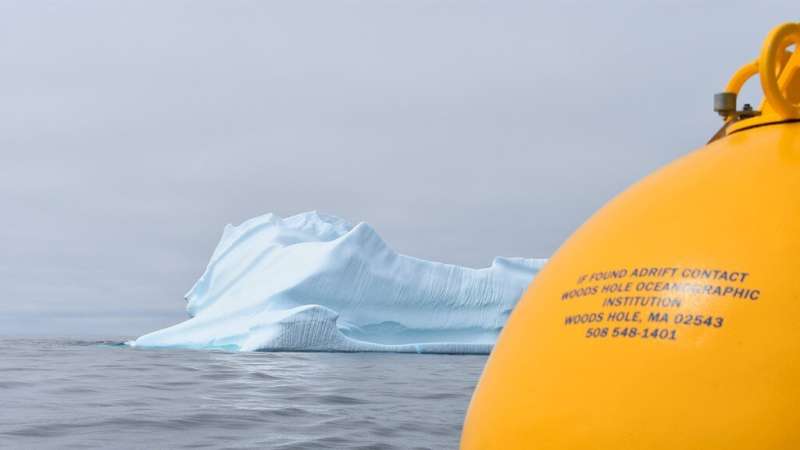When winds and currents align, ocean mixing goes deep
When warm, salty subtropical waters flow into the chilly North Atlantic, they cool, sink, and become the oxygen- and carbon-rich waters of the deep ocean. This convection is an important part of the global climate system, helping sequester carbon dioxide and heat from the atmosphere.
Convection typically is thought to occur vertically in the ocean’s mixed layer. New research by Le Bras et al. suggests, however, that convection with a sideways component may be involved in forming the deep waters of the North Atlantic.
The researchers used deep observations of velocities, salinity, and temperature collected from 2014 to 2018 by instrumented moorings deployed in the Overturning in the Subpolar North Atlantic Program to study circulation in the Irminger Sea between southern Greenland and Iceland. The Irminger is where some of the densest waters of the Atlantic Meridional Overturning Circulation form.
Greenland’s high topography creates extreme southward blowing winds that align with the Irminger Sea’s western boundary current. This wind-ocean interaction causes Ekman transport, a phenomenon that pushes denser, deeper water up over lighter surface layers.
The result, the team suggests on the basis of its analysis, is slantwise convection in the Irminger that plays a significant role in the seasonal overturning of Atlantic waters. Slantwise convection involves mixing of waters laterally along slanted isopycnals (surfaces of equal density), as opposed to vertically across density gradients. The researchers report that the process can stir waters up to four times deeper than the conventionally defined mixed layer depth.
Slantwise convection currently is not considered in most large-scale ocean modeling, the teams notes, adding that including this process is important for fully representing exchanges of heat, oxygen, and carbon in the ocean.
The research was published in Journal of Geophysical Research: Oceans.
More information:
I. A.‐A. Le Bras et al, Slantwise Convection in the Irminger Sea, Journal of Geophysical Research: Oceans (2022). DOI: 10.1029/2022JC019071
This story is republished courtesy of Eos, hosted by the American Geophysical Union. Read the original story here.
Citation:
When winds and currents align, ocean mixing goes deep (2022, October 31)
retrieved 31 October 2022
from https://phys.org/news/2022-10-currents-align-ocean-deep.html
This document is subject to copyright. Apart from any fair dealing for the purpose of private study or research, no
part may be reproduced without the written permission. The content is provided for information purposes only.

When warm, salty subtropical waters flow into the chilly North Atlantic, they cool, sink, and become the oxygen- and carbon-rich waters of the deep ocean. This convection is an important part of the global climate system, helping sequester carbon dioxide and heat from the atmosphere.
Convection typically is thought to occur vertically in the ocean’s mixed layer. New research by Le Bras et al. suggests, however, that convection with a sideways component may be involved in forming the deep waters of the North Atlantic.
The researchers used deep observations of velocities, salinity, and temperature collected from 2014 to 2018 by instrumented moorings deployed in the Overturning in the Subpolar North Atlantic Program to study circulation in the Irminger Sea between southern Greenland and Iceland. The Irminger is where some of the densest waters of the Atlantic Meridional Overturning Circulation form.
Greenland’s high topography creates extreme southward blowing winds that align with the Irminger Sea’s western boundary current. This wind-ocean interaction causes Ekman transport, a phenomenon that pushes denser, deeper water up over lighter surface layers.
The result, the team suggests on the basis of its analysis, is slantwise convection in the Irminger that plays a significant role in the seasonal overturning of Atlantic waters. Slantwise convection involves mixing of waters laterally along slanted isopycnals (surfaces of equal density), as opposed to vertically across density gradients. The researchers report that the process can stir waters up to four times deeper than the conventionally defined mixed layer depth.
Slantwise convection currently is not considered in most large-scale ocean modeling, the teams notes, adding that including this process is important for fully representing exchanges of heat, oxygen, and carbon in the ocean.
The research was published in Journal of Geophysical Research: Oceans.
More information:
I. A.‐A. Le Bras et al, Slantwise Convection in the Irminger Sea, Journal of Geophysical Research: Oceans (2022). DOI: 10.1029/2022JC019071
This story is republished courtesy of Eos, hosted by the American Geophysical Union. Read the original story here.
Citation:
When winds and currents align, ocean mixing goes deep (2022, October 31)
retrieved 31 October 2022
from https://phys.org/news/2022-10-currents-align-ocean-deep.html
This document is subject to copyright. Apart from any fair dealing for the purpose of private study or research, no
part may be reproduced without the written permission. The content is provided for information purposes only.
